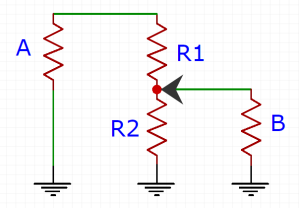This is a dang good question. Different values of pots don’t attenuate any more or any less than one another. A 1M pot is not inherently quieter/louder than a 10k pot. So why the eff are there so many values of potentiometers? It has to do with input and output impedance.
A pot is a made up of a resistance and a wiper making contact with the resistance. The point where the wiper makes contact divides the resistance into two parts. We usually take our output at the wiper and connect one end of the resistance to our source and the other end of the resistance to ground. As we turn the knob, the wiper moves to make one resistance larger or smaller relative to the other. You can think of it just like a resistor divider:

The arrow is our wiper, R1 is the portion of the resistance between the wiper’s contact and the input, and R2 is the portion of the resistance between the wiper and ground. The resistor marked “A” is standing in for the output impedance of the source connected to the pot. The resistor marked “B” is standing in for the input impedance of the next stage or amp.
From the perspective of A (the source), the pot’s value looks like R1 in series with R2 and B in parallel:
Zin = R1 + R2||B
When you have the volume very low, R2 is very small and so the impedance is basically R1 (or close to the pot value). When you have the volume turned up high, R1 is very small and so your impedance is dominated by R2||B. This is where it gets more interesting.
If B (the input impedance of the following stage) is large relative to R2, the input impedance of the pot is basically R2 (again, close to the pot value). If B is a relatively small value, the term R2||B is closer to B. Because the volume is all the way up, R1 does not add to the input impedance of the system as a whole. The input impedance in that case would be about the value of B.
Now, what about output impedance of the pot? From the perspective of the wiper, R1 and R2 are in parallel, so the output impedance is R1 || R2. If we also include the output impedance of the previous stage, the output impedance of the pot from the perspective of the wiper is:
(A + R1) || R2
The worst case scenario for the output impedance is when the two terms A + R1 and R2 are equal. This gives the largest value. If A is small relative to R1 and R2, the highest output impedance of the pot is therefore at half of its travel (linear pot). Here, the value of R1||R2 is 1/4 the value of R1 + R2 (or 1/4 the pot’s value). As A gets larger, the maximum possible output impedance also gets larger.
We want the pot value (R1+R2) to be much lower than the input impedance of the next stage or device (B) because that will let the pot behave most consistently in terms of impedance. We also want the pot value (R1 + R2) to be much larger than the source impedance of the preceding stage (A) because it keeps the maximum output impedance at or below 1/4 of the pots value.
Think of it all as a system. We want B much larger than 1/4 the pot value and the pot value much larger than A. A factor of 10x is pretty good. So, if you have a 25k input impedance on the stage following the pot (B), you’d want a pot value (R1 + R2) no larger than 10k. If your pot’s value is 10k, you’d want the source impedance feeding (A) it to be no larger than 1k.
Or, just add buffers to everything and let impedance math be damned.

